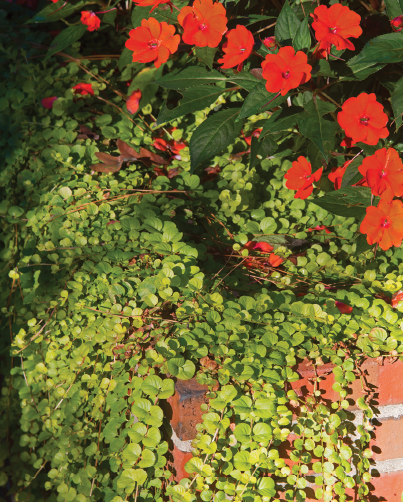It’s hard not to like golden creeping Jenny in the summer. Botanically known as Lysimachia nummularia ‘Aurea,’ this low-growing groundcover’s small, round, brilliant chartreuse leaves help to break up the blanket of green that slowly slips into the landscape as temperatures peak for the year.
The problem with creeping Jenny is that it can do its job too well as a groundcover. In some states to the north, the straight species’ aggressive tendencies have earned it the title of “invasive weed.” And although the cultivar ‘Aurea’ has been reported to be a more restrained grower, it can still go for a wild romp in the garden if left unattended.
In the right conditions, ‘Aurea’ easily spreads its strings of bright leaves through a planting bed, covering the ground with a glowing greenish-yellow carpet. As a bonus, in late spring to midsummer, small yellow flowers enhance the showy foliage.
However, if you love the look of ‘Aurea’ but are afraid it might eat your garden, there are more confined ways to display its beauty. Golden creeping Jenny loves moist conditions, so planting it in a bog garden with borders will make it feel right at home.
Although ‘Aurea’ is happy in damp areas, it is still tough enough to thrive in container plantings. Its golden leaves readily spill out of a pot like coins from a tilted treasure chest. This not only adds more interest to a planter, but it helps to soften the lines of a pot rim, allowing the container to meld better visually into the overall planting scheme.
‘Aurea’ can also be a real eye-catcher when allowed to flow over a retaining wall. Just like with pot rims, the masses of dazzling, dangling leaves will help break up the horizontal hold a long stretch of garden wall can have on the eye.
Golden creeping Jenny is rated hardy in USDA Zones 3 through 9, so it is a perennial that is capable of taking on winters in this area. But in containers, it can suffer during extended summer dry spells, so keep the watering can handy. It will do well in partially sunny to shady conditions, but with more sun (especially morning light) comes a more golden yellow to the leaves.
 ‘Aurea’ does best in well-worked soil that is high in moisture-retaining organic matter. Once its roots settle in, little chemical encouragement from commercial fertilizers is needed — so just step back and watch the glow grow!
‘Aurea’ does best in well-worked soil that is high in moisture-retaining organic matter. Once its roots settle in, little chemical encouragement from commercial fertilizers is needed — so just step back and watch the glow grow!
L.A. Jackson is the former editor of Carolina Gardener Magazine. Want to ask L.A. a question about your garden? Contact him by email at: lajackson1@gmail.com.
To Do in the Garden
August
- There is still time to squeeze more produce out of the veggie patch by adding fast-maturing plants such as eggplants, peppers, squash, cucumbers and tomatoes early this month.
- Cool-season vegetables such as collards, broccoli, cauliflower, lettuce and spinach can also be started now from seed in flats in a shady location.
- Bermuda grass lawns will benefit from a one pound per thousand square feet application of nitrogen this month. Also, zoysia and St. Augustine lawn can be fertilized now with one half pound of nitrogen per thousand square feet.
- Want fewer summer weeds? The answer is simple: pull the unwanted plants before their flowers go to seed, not after.
- Late August is a good time to begin digging and dividing cannas, irises, primroses and daylilies.
- It’s time to plant bulbs. No, not spring-flowering bulbs but rather fall-blooming beauties such as colchicum, sternbergia and autumn-flowering crocus that will put on a surprise show late in the year before winter grips the garden.
- Neighborhood dogs and cats enjoying your garden a little too much? Sprinkle fine-ground black pepper around their favorite play spots. A snoot full and a few sneezes later, and they will think twice about sneaking into your garden again.
- How does a nice drink of water sound on a hot August day? Gardeners like it, and so do birds, so keep the birdbath filled and give it a light cleaning at least once a week.
 Timely Tip
Timely Tip
The pursuit of perfectly shaped, homegrown tomatoes can be spoiled at this time of the gardening season by a problem known as cracking. This condition is marked by concentric, unappetizing rings circling the stems or vertical splits along the sides of ripening fruits.
The problem usually occurs when a big rain falls after an extended dry spell. So much ground moisture suddenly available to tomato plants causes the fruits to expand quickly and literally crack out of their skins.
Mulching the plants will help steady the moisture supply, and a regular watering schedule when the rains don’t come will also prevent this disorder.






